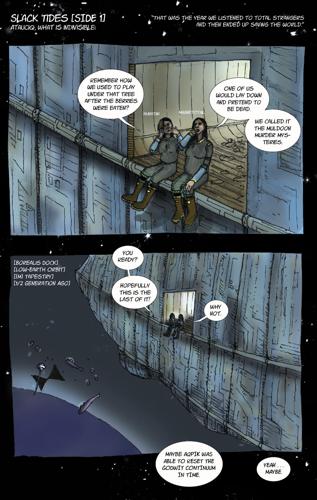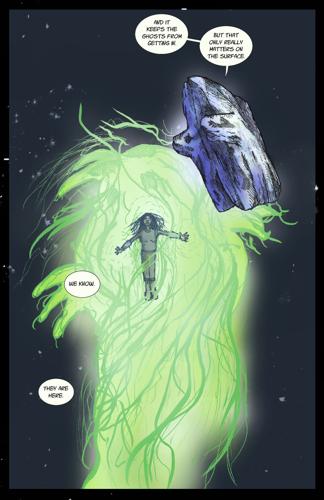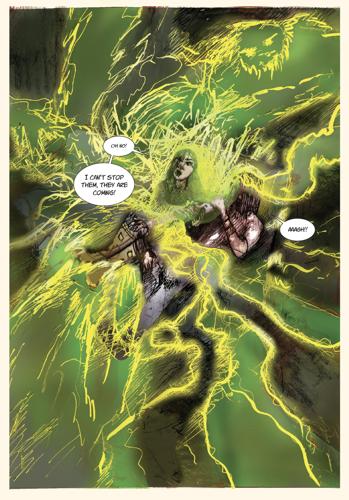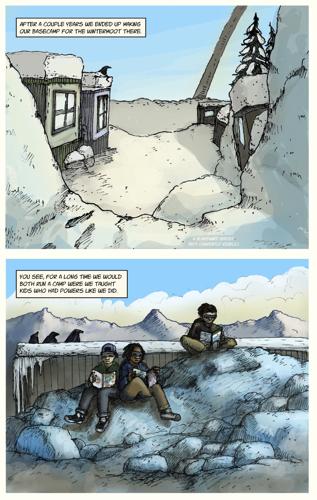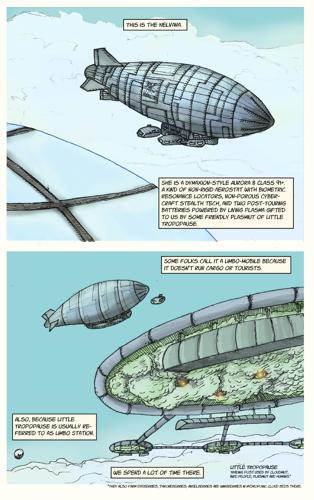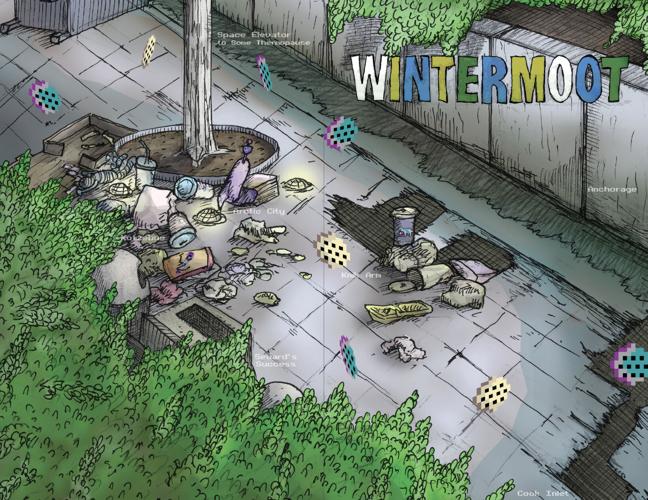Step into the world of “Wintermoot” and be prepared to travel visually, textually, spatially, chronologically and within your own imagination to places you’ve never before been.
The creation of Anchorage visual artist and comics creator Nathan Shafer, “Wintermoot” is a yet-to-be completed series of 12 comic books with a revolving array of super-powered lead characters doing battle with an assortment of sometimes nebulously and other times outright evil villains, ebbing and flowing through an imagined Alaska landscape (based on a historical proposal) from which it frequently hurls off into the depths of space, where some of those bad guys originate.
“Wintermoot Volume Two: Slack Tides” gathers issues five through eight of Shafer’s series. The subtitle refers to the story arc they contain, and is drawn from the term used to describe the brief period between low and high tides when the sea’s movement pauses, and mysteries beneath the water are revealed on the sand. It’s an analogy fitting for the progress of events, which begin almost as an outgoing sea. Here interlaced yet distinct entities weave their way through the pages to come, emerging from beneath the waves and displaying themselves while they can. It continues into the final pages, when the water comes rushing back in, and a cataclysmic comic book battle ensues, the sort Marvel Comics was famous for in its heyday. A conflict against otherworldly beings that only the heroes are equipped to confront, using powers both vast and limited, while recognizing just what possession of those powers implies.
In between lies a sprawling universe, and good luck following it sequentially. The book slides back and forth through time and on and off the planet, with plot lines shifting just as rapidly. This is intentional, Shafer explains in one of the numerous lengthy text sections that accompany his comic narratives.
“The stories themselves are nonlinear, following the storytelling traditions that have been present in Alaska forever,” he explains, referencing the Native mythology structure that the book is inspired by but never steals from. “A lot of Wintermoot will read like a series of conceptual art proposals, which at their core they are.”
“Wintermoot” is part of a shared universe created by a collective know as Luk’ae Tse’Taas Comics (Fish Head Soup Comics), a concept that has been built primarily, but far from entirely, within the comics medium. It sprang from a series of stories gathered under the title “Dirigibles of Denali” that were set in an Alaska where three ultramodern, climate-controlled domed cites had been built, a notion originally forwarded by the state’s somewhat eccentric but certainly innovative minded one time senator Mike Gravel (Gravel is given coauthor credit in “Wintermoot” as the originator of a central component of this entire enterprise).
Fish Head Soup Comics seeks to create an Alaska-centric realm for comics creators building the shared universe. It has also played host to the children’s manga-like series “Chickaloonies” created by Dimi Macheras and Casey Silver, “Wildemen of Denali” penned by the late Richard Perry and now being brought to life by artist David Brame, and the “Dirigibles of Denali” books themselves. The contributors are creating a sprawling world that is particularly focused on bringing Alaska Native cultures into the realm of comics, new media, and augmented reality.
“Wintermoot” combines all of these elements. Many of its varied heroes are Alaska Natives whose superpowers are rooted in the mythological tales of their cultures. They meander through a universe that itself travels well beyond the pages of the book itself, which includes links to an augmented reality that Shafer, who only recently came to comics creation, helped initiate amidst his lengthy excursions around the internet, creating new media for self expression.
“Wintermoot” is actually a collaborative effort, with Shafer at its helm. The stories here are credited to an abundance of coauthors and fellow creators, including Perry, who Shafer offers a poignant tribute to midway through the book. “I am filling in the missing pieces,” Shafer writes, acknowledging that so much of what has become Luk’ae Tse’Taas initially flowed from Perry’s boundless imagination.
Which isn’t to say that Shafer lacks the same attribute. “Wintermoot” wanders along from a trailer park in Anchorage’s Muldoon neighborhood and onward to the imagined domed cities, into the old Socialists and Pioneers labor hall that once existed in Alaska prior to World War II, out to the Faroe Islands, onboard sea ships and space ships, and across vast wildernesses as well as city streets. Here characters powered by ice, northern lights, multi-linguistic skills, cyberingian implants, the plasmaverse, lactoverse and other imagined universes, and much more confront alien invaders, partially-human chimeras, and, in nod to current events, a racist, power hungry, far-right political leader.
The book also veers even off this course, especially in the text sections, which touch on such subjects as an imagined Alaska death metal scene with global popularity, a rap battle between several species of corvids on an Anchorage street, alternative histories, “Dirigibles of Denali” tales, poetry, factual content, and other topics.
Trying to find a narrative thread in it all is hopeless, but that’s the point. As I noted in my review of the first “Wintermoot” book, Shafer is treading similar ground as the late William S. Boroughs, who also tossed his readers through a windmill of science fiction, mythology, wry observation, and confusing collages of words and imagery designed to yank them out of their comfort zones. Shafer, however, accomplishes this without the extreme violence, grotesqueries, and profanities that epitomized so much of Boroughs’ brilliant but frankly adult-oriented writings. Shafer’s work is appropriate for kids and intriguing to adults. Minds will be blown despite the reader’s age.
Four more issues which will eventually comprise one more book await us in the “Wintermoot” series. And from there we’ll see where Shafer guides us next. Based on where he’s led readers thus far, it will be, like the world of “Wintermoot,” someplace they never imagined could be.
David James is a freelance writer who lives in Fairbanks. He can be emailed at nobugsinak@gmail.com.


